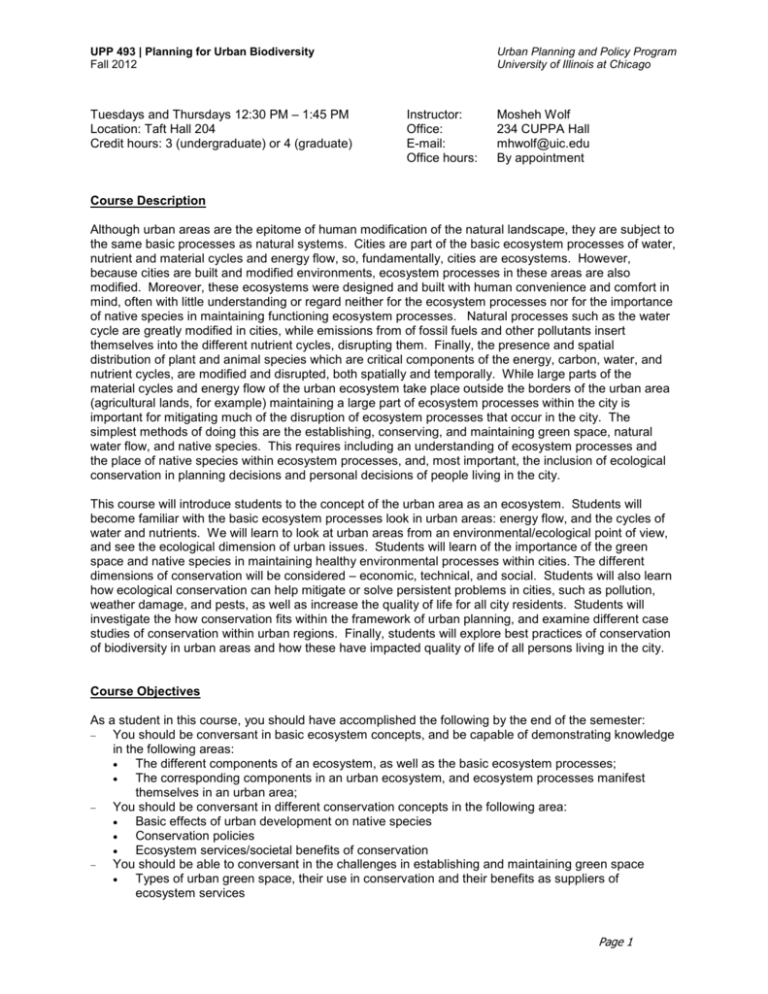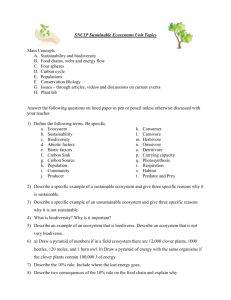UPP 493: Planning for Urban Biodiversity
advertisement

UPP 493 | Planning for Urban Biodiversity Fall 2012 Tuesdays and Thursdays 12:30 PM – 1:45 PM Location: Taft Hall 204 Credit hours: 3 (undergraduate) or 4 (graduate) Urban Planning and Policy Program University of Illinois at Chicago Instructor: Office: E-mail: Office hours: Mosheh Wolf 234 CUPPA Hall mhwolf@uic.edu By appointment Course Description Although urban areas are the epitome of human modification of the natural landscape, they are subject to the same basic processes as natural systems. Cities are part of the basic ecosystem processes of water, nutrient and material cycles and energy flow, so, fundamentally, cities are ecosystems. However, because cities are built and modified environments, ecosystem processes in these areas are also modified. Moreover, these ecosystems were designed and built with human convenience and comfort in mind, often with little understanding or regard neither for the ecosystem processes nor for the importance of native species in maintaining functioning ecosystem processes. Natural processes such as the water cycle are greatly modified in cities, while emissions from of fossil fuels and other pollutants insert themselves into the different nutrient cycles, disrupting them. Finally, the presence and spatial distribution of plant and animal species which are critical components of the energy, carbon, water, and nutrient cycles, are modified and disrupted, both spatially and temporally. While large parts of the material cycles and energy flow of the urban ecosystem take place outside the borders of the urban area (agricultural lands, for example) maintaining a large part of ecosystem processes within the city is important for mitigating much of the disruption of ecosystem processes that occur in the city. The simplest methods of doing this are the establishing, conserving, and maintaining green space, natural water flow, and native species. This requires including an understanding of ecosystem processes and the place of native species within ecosystem processes, and, most important, the inclusion of ecological conservation in planning decisions and personal decisions of people living in the city. This course will introduce students to the concept of the urban area as an ecosystem. Students will become familiar with the basic ecosystem processes look in urban areas: energy flow, and the cycles of water and nutrients. We will learn to look at urban areas from an environmental/ecological point of view, and see the ecological dimension of urban issues. Students will learn of the importance of the green space and native species in maintaining healthy environmental processes within cities. The different dimensions of conservation will be considered – economic, technical, and social. Students will also learn how ecological conservation can help mitigate or solve persistent problems in cities, such as pollution, weather damage, and pests, as well as increase the quality of life for all city residents. Students will investigate the how conservation fits within the framework of urban planning, and examine different case studies of conservation within urban regions. Finally, students will explore best practices of conservation of biodiversity in urban areas and how these have impacted quality of life of all persons living in the city. Course Objectives As a student in this course, you should have accomplished the following by the end of the semester: You should be conversant in basic ecosystem concepts, and be capable of demonstrating knowledge in the following areas: The different components of an ecosystem, as well as the basic ecosystem processes; The corresponding components in an urban ecosystem, and ecosystem processes manifest themselves in an urban area; You should be conversant in different conservation concepts in the following area: Basic effects of urban development on native species Conservation policies Ecosystem services/societal benefits of conservation You should be able to conversant in the challenges in establishing and maintaining green space Types of urban green space, their use in conservation and their benefits as suppliers of ecosystem services Page 1 UPP 493 | Planning for Urban Biodiversity Fall 2012 Urban Planning and Policy Program University of Illinois at Chicago Costs of establishing and maintaining green space Challenges in incorporating social justice concepts in placement and cost of green space You should be able to identify best practices in planning with ecological conservation in mind Requirements Grading in the course is based on a group assignment ASSIGNMENT SHORT DESCRIPTION EXPECTED PRODUCT Grade DUE 1. IDENTIFYING ENVIRONMENTAL ISSUES Presentation of a specific conservation issue/challenge in an urban location Short oral presentation (10 minutes) Short written summary (1-2 pages) 15% (oral presentation) + AV material 10% (written summary) By presentation Develop plan that would meet the conservation challenge while maximizing societal benefit. Include best estimates of cost. Oral Presentation (20 minutes) of plan. Extended written plan (roughly 20 pages) 20% (oral presentation) + AV 30% (Summary paper) By presentation 3. SELECT READINGS Assign appropriate reading for presentation. Summary of presentation, reference to two or three articles (any source) 5% During first presentation 4. CLASS PARTICIPATION Come to class; read material assigned by instructor and by presenters; actively participate in discussions; lead discussion during presentations. 20% weekly 2. PLANNING SOLUTION Nov. 9 Dec, 14 Grade scale: 90%-100% - A; 80%-89% - B, 70%-79% - C; 60%-69% - D; below 60% - F Policies and procedures: Teams: Teams will be formed in the first week of classes Team membership must be approved by me The topic should be chosen by the third or fourth week – teams that take too long to decide will not be sufficiently prepared for their first presentation I will schedule meetings with groups to discuss their progress after presentations and by appointment. Teams may submit drafts earlier than the deadline for comments, as well. However, I will not accept work for review less than a week prior to any deadline. Remember, the earlier you submit a draft, the more time you will have to incorporate corrections. Late submission of summaries will be penalized at the rate of 1% (of total grade) per week Page 2 UPP 493 | Planning for Urban Biodiversity Fall 2012 Urban Planning and Policy Program University of Illinois at Chicago The final paper will not be accepted after December 17th, because of the proximity of the due date to submission of final grades. Exceptions will be considered on an individual basis. I expect all students on a team to participate in the work. Any student slacking or not pulling their load will be penalized individually. Plagiarism, copying, or other such unethical behavior will affect the grade as well!!! Not to mention disciplinary actions as outlined in the Student Conduct Process Attendance: Attendance is expected for every class, and absences will affect your participation grade. Presence during student presentations and guest lectures and especially important. Acceptable reasons for missing classes are religious holidays, family life events, job/internship/grad school interviews, and professional conferences. When possible, please notify me ahead of time. Other reasons will be weighed on a case-to-case basis. Required Materials Readings will be drawn from the following books: Alberti, Marina. 2008. Advances in Urban Ecology. New York, NY: Springer. Suggested: Forman, Richard T. T. 2008. Urban Regions. Cambridge, UK: Cambridge University Press Gaston, Kevin J., ed. 2010. Urban Ecology. Cambridge, UK: Cambridge University Press Additional readings and other materials will be available on the course Blackboard site, as will the lecture slides. Course Outline Week 1 (August 28, 30): Ecology, the Ecosystems, and Ecosystem Processes Readings No readings Week 2 (September 4, 6): The Urban Area as an Ecosystem - Introduction Readings Alberti: chapters 2, 3 Week 3 (September 11, 13): Urban Ecosystem Processes Readings Alberti: chapters 5, 6, 7 Week 4 (September 18, 20): Urban Green Space and the Concept of Ecosystem Services Readings Bolund, P. and Hunhammar, S. 1999. Ecosystem services in urban areas. Ecological Economics, 29: 293-301 Page 3 UPP 493 | Planning for Urban Biodiversity Fall 2012 Urban Planning and Policy Program University of Illinois at Chicago Morancho, A.B. 2003. A hedonic valuation of urban green areas. Landscape and Urban Planning, 66: 3541. Thompson C.W. 2002. Urban open space in the 21st century. Landscape and Urban Planning. 60:. 5972. Costanza, R., Darge, R., Degroot, R., Farber, S., Grasso, M., Hannon, B., Limburg, K., Naeem, S., Oneill, R. V., Paruelo, J., Raskin, R. G., Sutton, P., and Vandenbelt M. 1997. The value of the world’s ecosystem services and natural capital. Nature 387: 253-260 Week 5 (September 25): Ecosystem services of Urban Greenspace Readings Tzoulas, K.,Korpela,K.,Venn,S.,Yli-Pelkonen,V., Kazmierczak, A.,Niemelä, J.,James,P. 2007. Promoting ecosystem and human health in urban areas using Green infrastructure: a literature review. Landscape Planning 81: 167–178. La Greca, P. La Rosa, D., Martinico, F., & Privitera, R. 2011. Agricultural and green infrastructures: The role of nonurbanized areas for eco-sustainable planning in a metropolitan region. Environmental Pollution 159: 2193-2202 Week 5 (September 27): Ecosystem services of Urban Greenspace – Field Trip We’ll be travelling to Millenium Park to look at the different types of ecosystem services offered by this park. Week 6 (October 2, 4): Urban Biodiversity Readings Savard, J. L., Clergeau, P., and Mennechez, G. 2000. Biodiversity concepts and urban ecosystems. Landscape and Urban Planning 48: 131-142 Angold, P. G., Sadler, J. P., Hill, M. O., Pullin, A., Rushton, S., Austin, K., Small, E., Wood, B., Wadsworth, R., Sanderson, R., and Thompson, K. 2006. Biodiversity in urban habitat patches. Science of the Total Environment 360: 196-204 Week 7 (October 9, 11): Biodiversity, Ecosystem Services, and Ecosystem Processes Readings Kremen, C. 2005. Managing ecosystem services: what do we need to know about their ecology?. Ecology Letters, 8: 468–479 Díaz, S., Fargione, J., Chapin, F. S. III, and Tilman, D. 2006. Biodiversity loss threatens human wellbeing. PLoS Biology 4: e277 doi:10.1371/journal.pbio.0040277 Week 8 (October 16, 18): Conservation of Biodiversity Readings The book chapter on Blackboard Week 9 (October 23, 25): Incorporating Ecological Conservation into Planning Readings Page 4 UPP 493 | Planning for Urban Biodiversity Fall 2012 Urban Planning and Policy Program University of Illinois at Chicago Margules, C. R. and Pressey, R. L. 2000. Systematic conservation planning. Nature 405: 243-253 Groves, C. R., Jensen, D. B., Valutis, L. L. Redford, K. H. Shaffer, M. L. Scott, J. M., Baumgartner, J. V. Higgins, J. V., Beck, M. W., and Anderson, M. G. 2002. Planning for biodiversity conservation: putting conservation science into practice. BioScience 52: 499-512 Week 10 (October 30, November 1): Student Presentations of Project Outlines Written summaries due November 8 Week 11 (November 6, 8): Socioeconomic Factors, Social Justice, and Conservation of Urban Biodiversity Readings Scott R. Loss, S. R, Ruiz, M. O., and Brawn, J. D. 2009. Relationships between avian diversity, neighborhood age, income, and environmental characteristics of an urban landscape. Biological Conservation 142: 2578–2585 Kinzig, A. P., Warren, P., Martin, C., Hope, D., and Katti, M. 2005. The effects of human socioeconomic status and cultural characteristics on urban patterns of biodiversity. Ecology and Society 10: 23. [online] URL: http://www.ecologyandsociety.org/vol10/iss1/art23/ Adams, W. M. and Hutton, J. 2007. People, Parks and Poverty: Political Ecology and Biodiversity Conservation. Conservation and Society 5: 147-83 Campbell, S. 1996. Green Cities, Growing Cities, Just Cities? Urban Planning and the Contradictions of Sustainable Development. Journal of the American Planning Association 62: 296-312 Week 12 (November 13, 15): Planning for Biodiversity – Case Studies Readings Week 13 (November 22): Planning for Biodiversity – Case Studies Field trip to the Bloomingdale trail. Students will look at planning strategies to support biodiversity in this project (alternatively – presentation in class) Week 14 (November 27, 29): Student Presentations of Final Project/Case Studies Week 15 (December 4, 6): Student Presentations of Final Project Summary paper due Tuesday, December 11th Page 5








